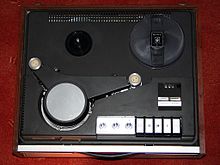LDL (video format)
LDL is an analog video format created by Philips in 1968 for the home consumer market. It supported black and white recording with a video bandwidth of around 2.2 MHz. The recording was first made on a tape only ½ inch (1.27 cm) wide and without a surrounding cassette . Using 450 m tape reels, 45 minutes of video and sound could be recorded. The first black and white video format was developed by Ampex back in 1956 .
Development history
In 1969, Philips presented the video recorder LDL 1002 and the structurally identical LDL 1000 with a simpler housing at the 26th radio exhibition in Stuttgart and the Hanover Fair ; and Grundig brought an identical model under the name BK 100 to the market. With device prices below DM 2,000, the recording of television broadcasts became affordable for home users for the first time.
In design, size and weight, the VCR approximately corresponded to the then tape recorders . Operation was kept relatively simple for home use; so took place z. B. the control of picture and sound by two level controls. With such a recorder, the signals could then be recorded directly from the television receiver; an adapter was required for this - either for the television standard PAL or the American television system NTSC . It was also necessary to adjust the track position at the beginning of each playback .
For image recording, however, you generally need a significantly larger bandwidth compared to pure sound recording . Therefore, video recorders place much higher demands on the recording process: Either the tape would have to be fed past the rigid recording or playback heads commonly used in tape recorders many times faster , which would, however, result in a tape speed of approx. 5 m / s. Or it results from this - if this is to be avoided not least for economic reasons - the requirement of a higher recording density . The development of the so-called helical track recording process with two rotating video heads served this purpose , whereby a transport speed of the tape of 18.48 cm / s is sufficient. However, the rotation of the head drum results in a relative speed between tape and head of 8.08 m / s. The head drum is wrapped around half of the tape, i.e. at 180 °. The helical tracking method had already been introduced by the Ampex company in 1961, but for 2 inch (5.08 cm) wide belts.
A special technical feature are the two belt disks driven by the capstan motor via a magnetic coupling . The head drum is driven by a flat belt and braked down to the set speed by means of an eddy current brake.
The LDL devices were the technical predecessors of the first VCR video recorder with cassette, the Philips N1500; it came on the market in 1971. Its format is considered the first commercially successful video cassette format for home use.
See also
Web links
Individual evidence
- ^ Museum of early consumer electronics and 1st achievements , rewindmuseum.com.
- ↑ a b Philips video recorder LDL 1002 ( memento of 23 August 2006 in the Internet Archive ), in Der TV-Amateur - AGAF newsletter , edition 02/69.
- ^ Video History - Philips LDL-1000 (1968) , videointerchange.com.
